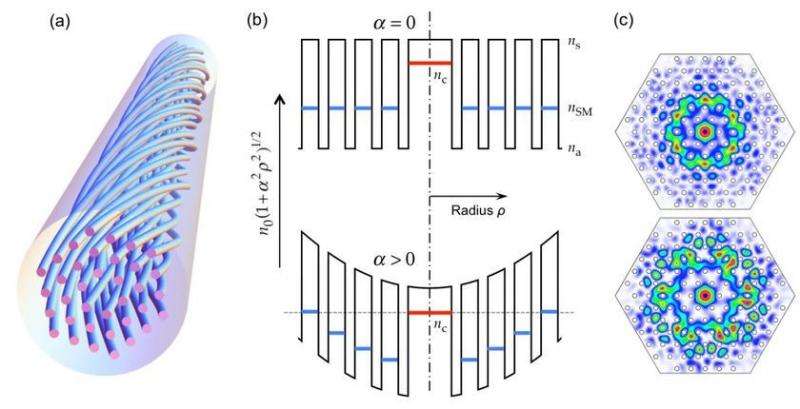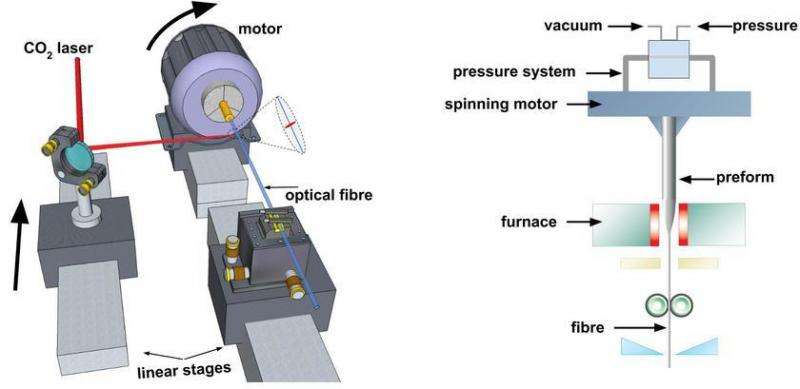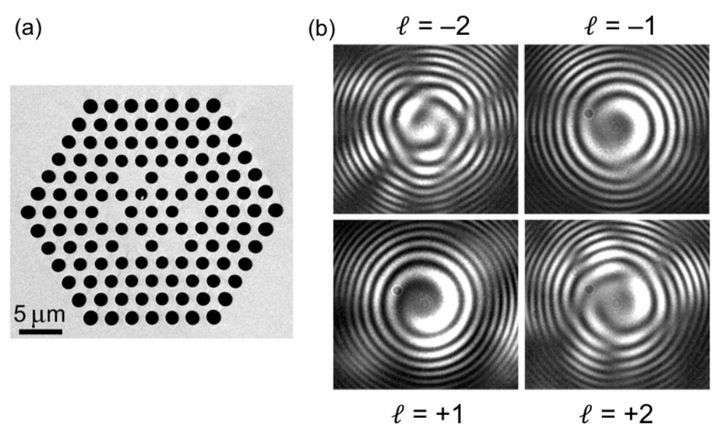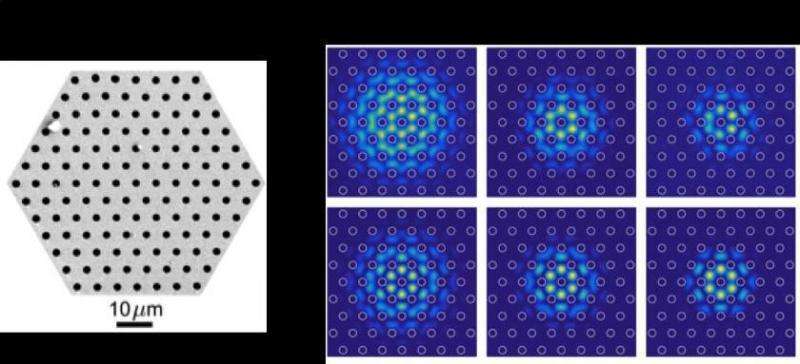Helically twisted photonic crystal fibres

Photonic crystal fibres (PCF) are strands of glass, not much thicker than a human hair, with a lattice of hollow channels running along the fibre. If they are continuously twisted in their production, they resemble a multi-helix. Twisted PCFs show some amazing features, from circular birefringence to conservation of the angular momentum. The biggest surprise, however, is the robust light guidance itself, with no visible fibre core. The basis for this are forces which, like gravitation, are based on the curvature of space.
Chiral materials consist of many identical units (molecules or nanostructured elements) that are either randomly oriented in solution or arranged in an ordered fashion. They are ubiquitous in nature—for example, most biological molecules come in right and left-handed forms—and are finding an increasing number of applications in science and technology. Twisted photonic crystal fibre (t-PCF), in contrast, consists of a single uniaxial chiral unit that is infinitely extended in the third dimension—the direction of the twist. PCF itself typically consists of a hexagonal array of hollow microchannels running along the length of a glass fibre ~100 µm thick, so that when twisted it resembles a "multi-helix" of spiralling microchannels around a central axis (Fig. 1(a)).
Over the past several years we have been studying the behaviour of light in a range of different types of t-PCF, in the process uncovering some surprising phenomena and exploring potential applications.
We use two techniques for producing t-PCF. In the first, an untwisted PCF is post-processed under CO2 laser heating, the fibre being mounted between a motorized rotation stage and a rigid support (Fig. 2(a)). As the motor rotates, the focused 10 µm laser beam is scanned along the fibre using a steering mirror fixed to a precision motorized translation stage. Once the target twist period and sample length are set, the laser power and the scanning speed are chosen so as to heat the fibre to the glass-softening temperature. The writing process is computer-controlled and is capable of achieving twist periods as short as 300 μm. The second technique involves spinning the glass preform during fibre drawing, using a motor rotating at a few thousand rpm and a rotary joint with multiple inlets for controlling the pressure inside the hollow channels (Fig. 2(b)). It has the advantage that long lengths (100s of metres) of helical PCF with twist periods of a few millimetres can be readily fabricated.

Topological effects
The propagation of electromagnetic waves in helical structures began in earnest in the 1940s, with the invention of the travelling-wave tube amplifier. In this device a microwave signal is guided along a helical wire that spirals around an axially propagating electron beam. Since the physical distance over which the spiralling microwave signal travels is longer than the distance directly along the axis, its group and phase velocities are both effectively reduced. By appropriate design the velocity difference between the two waves can be adjusted, permitting the microwave signal to be amplified with power from the electron beam. In a similar manner, the geometrical stretching of the cladding structure in a t-PCF causes the effective optical path-length along the axis, and thus the effective refractive index, to increase topologically with radius ρ following the relationship neff(ρ) = n0(1 + α2ρ2)1/2 where n0 is the index in the untwisted case and α the twist rate in rad/m (see Fig. 1(b)).
Spectral dips in t-PCF with single core
This topological effect makes it possible for example to phase-match light guided in a central solid glass core (modal index nc) to the fundamental space-filling mode in the cladding (phase index nSM in the untwisted fibre) with the result that light can leak out into cladding modes at certain wavelengths. This results in a series of dips in the transmission spectrum, caused by anti-crossings between the core mode and leaky ring-shaped cladding modes (Fig. 1(c)) carrying orbital angular momentum (OAM), each dip corresponding to a different OAM order. Since the cladding light is diverted by the hollow channels into a spiral path, the azimuthal component of its wavevector must take values that yield a round-trip phase advance that is an integer multiple of 2π, where is the OAM order. This leads to the condition:
(ℓ λℓ) / (2π) = naz ρ = nSM ρ sinΨ ≈ nSM α ρ2 (1)
where is the dip wavelength of the OAM order, naz the azimuthal component of refractive index, and the local angle between the hollow channels and the fibre axis. Eq. (1) yields remarkably good agreement with experimental measurements, showing in particular that the dip wavelengths scale linearly with the twist rate. We have used the twist and strain sensitivity of these dips to construct an all-optical twist-strain transducer.

Helical Bloch waves
Understanding the physics of light propagation in t-PCF is quite challenging, because the natural coordinate system—helicoidal—is non-orthogonal. This led us to introduce a new concept: helical Bloch waves. The optical Bloch waves of any untwisted periodic structure are described by the product of a periodic function P(r) (with periodicities that match the structure) and a term representing the phase progression of the Bloch wave. A convenient physical picture for the modes guided in a t-PCF can be constructed by generalising Bloch's theorem so that the azimuthally periodic function follows the twist, taking the form where is the radial coordinate and the azimuthal angle. At any given value of z, P will repeat at angular intervals , where N is the number of times the structure repeats over one revolution 2π. The Bloch waves can then be calculated analytically using an expansion in terms of azimuthal harmonics of OAM order . Substituting this field Ansatz into Maxwell's equations allows the dispersion relation to be derived.
To explore the properties of helical Bloch waves, we fabricated a t-PCF with a ring of six solid glass "satellite" cores around its axis (Fig. 3(a)). The hollow channels had diameter 2 µm, spaced by 3 µm, and the twist rate was 2.9 rad/mm. This structure supports 6 non-degenerate helical Bloch modes with different values of orbital angular momentum, in both left and right circularly polarised states. To determine the OAM order of the modes guided through the t-PCF, the output was superimposed on to a divergent Gaussian beam and the resulting fringe pattern imaged using a CCD camera. The single- and double-spiral interference patterns in Fig. 3(b), which were recorded at a wavelength of 632.8 nm, confirm that the fibre generates optical vortices and preserves the magnitude and sign of the OAM for all four modes. Similar experiments carried out at multiple wavelengths and for fibres up to 50 m long have confirmed that the t-PCFs preserve the magnitude and sign of the OAM.

Guidance of light in twisted space
We have discovered a new mechanism of light guidance, based on a t-PCF with no core. Cleaving the fibre and examining its cross-section reveals a complete absence of any structure at which light could be trapped (see Fig. 4(a)). Nevertheless it supports a guided mode: the helical twist creates a topological channel within light is robustly trapped. This arises from the quadratic increase in optical path length with radius (mentioned above), which produces a radial gradient in axial refractive index, creating a potential well within which light is confined by photonic bandgap effects. Using mathematical tools from general relativity, we have shown that the geodesics of the light follow closed spiral paths within the topological channel, forming modes that carry OAM. The effective area of these modes decreases with twist rate α, so that by varying the twist rate along the fibre, it would be possible to create fibres whose mode-field diameter changes with position. Unlike in conventional index-guiding fibres, where the guided mode shifts towards the outside of the bend ("normal cornering"), this highly unusual mode shifts inwards towards the bend ("anomalous cornering"). Hamiltonian optics shows that the mode may be viewed as having negative effective mass (caused by the opposite sign of the dispersion surface curvature), so that it moves in the opposite direction when subject to bend forces.
Conclusions
The ability of t-PCF to generate and support OAM modes, as well as providing optical activity and circular dichroism, suggests that it may become useful in many applications. The series of transmission dips at twist-tunable wavelengths in solid-core PCF has applications in sensing and filtering. The transmission and preservation of circular polarisation states makes t-PCF very interesting for current sensing based on Faraday rotation. Its ability to robustly transmit pure OAM states over long distances may lead to applications in particle manipulation and telecommunications. It seems likely that many of these effects and phenomena will move into real-world applications in the near future. As yet unexplored is the use of t-PCF in nonlinear optics and fibre lasers, where the combination of circular and OAM birefringence with control of group velocity dispersion may offer opportunities for new kinds of mode-locked soliton lasers, wavelength conversion devices and supercontinuum sources.
More information: R. Kompfner. The Traveling-Wave Tube as Amplifier at Microwaves, Proceedings of the IRE (2007). DOI: 10.1109/jrproc.1947.231238
G. K. L. Wong et al. Excitation of Orbital Angular Momentum Resonances in Helically Twisted Photonic Crystal Fiber, Science (2012). DOI: 10.1126/science.1223824
Xiaoming Xi et al. Measuring mechanical strain and twist using helical photonic crystal fiber, Optics Letters (2013). DOI: 10.1364/OL.38.005401
P. St. J. Russell. Optics of Floquet-Bloch waves in dielectric gratings, Applied Physics B Photophysics and Laser Chemistry (2004). DOI: 10.1007/bf00697490
X. M. Xi et al. Orbital-angular-momentum-preserving helical Bloch modes in twisted photonic crystal fiber, Optica (2014). DOI: 10.1364/OPTICA.1.000165
P. St.J. Russell et al. Helically twisted photonic crystal fibres, Philosophical Transactions of the Royal Society A: Mathematical, Physical and Engineering Sciences (2017). DOI: 10.1098/rsta.2015.0440
P.S.J. Russel et al. Hamiltonian optics of nonuniform photonic crystals, Journal of Lightwave Technology (2002). DOI: 10.1109/50.802984
G. K. L. Wong et al. Enhanced optical activity and circular dichroism in twisted photonic crystal fiber, Optics Letters (2015). DOI: 10.1364/OL.40.004639
Journal information: Science , Optics Letters , Optica
Provided by Max Planck Society




















